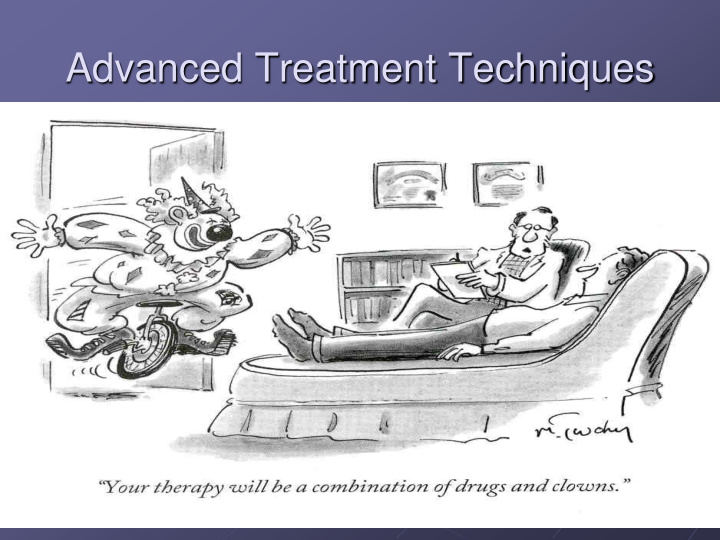



Advanced Treatment Techniques
Old and Outdated Thinking: Something is Wrong with the Person Moral Character Psyche
Newer and More Advanced Thinking: Something is Wrong with their Circumstances “There is no such thing as a bad boy, only bad environment, modeling, and teaching” Father Edward Flanagan
Assessment: Identify the Circumstances Treatment: Change Them
What Difficult (and all people) Really Want Acceptance Approval Appreciation
Circumstantial Learning: The Basis for all Successful Treatment Behavior that produces a change in circumstances Directional effect on behavior Quality of change Repetition needed Size of change Timing of change
Carrot Stick
Advanced Behavioral Techniques Increase Presence of carrots Appropriate behavior — carrot sequences Appropriate behavior — stick sequences Decrease Presence of sticks Appropriate behavior — stick sequences Inappropriate behavior — carrot sequences
Matching Law Relative rates of behavior match the relative rates of reinforcement the behavior produces Choice is determined by probability of reinforcement and the effort necessary to obtain it
Positive Peer Reporting Social Rejection Social Skills Training High Status Peers Ken Kesey and “Feed the Hungry Bee” 2 nd Hand Compliments Trade List PPR
Positive Peer Reporting Method Select Child Who? How? Select targets Prosocial behavior Select time End of class? Day? Rewards for playing Points? Privileges? Praise?
Positive Peer Reporting Measures Positive Interactions Cooperation, assistance, conversation, other pleasantries Negative Interactions Verbal (e.g., criticism, yelling) Physical (e.g., hitting, shoving) Neutral Opportunity w/o interaction Social standing
Interactional Ratios Marriage Success Depends on ratio between positive and negative interactions Positive Interactions E.g., favors, affection, point awards Negative interactions E.g., criticism, insults, point fines
Interactional Ratios: Clinical Suggestions Discover routine appropriate behavior The miracle of the tucked in shirt Eye contact Inhibition Manipulate Reward Systems 5 to 1 ratio Pay for Criticism & Discipline 5 to 1 ratio
Response Disequilibrium Theory Premack Principle Grandma’s rule Response Deprivation I/C > O i /O c Reinforcement effect I/C < O i /O c Punishment effect Response Disequilibrium Attempt to regain baseline rates
Response Disequilibrium Applications Home Resources Bedtime All electronic equipment Rides and freedom in general Toy rotation Task-based Grounding Non critical jobs All activities ceased except Jobs, homework, critical outings
Task-Based Grounding
Sample Jobs Clean bathtubs Clean 2 square feet of grout Clean shower Vaccum an entire Any set of room baseboards Shine wheels on car Behind the toilet Wash car Any window Sweep garage Scrub floor Polish shoes (dad’s Organize a closet and/or mom’s)
Rules for Grounded Children Attending school and No visitors scheduled extra- Nothing with a battery urricular activities Nothing with an Performing required electric current chores Nothing with door Following house rules leading outside Staying in room No snacks except for meals, Nothing with a plug homework, chores or school
Rules for Parents No nagging No reminding about jobs to be done No discussing the rules No explaining the rules
Behavioral Momentum
Behavioral Momentum Mass = Response strength Velocity = Response rate High probability commands High momentum Low probability commands Low momentum
Behavioral Momentum General Findings Hi P increases compliance with low p General Implications Start with low effort high payoff commands Boys town Cults Honey do
Extinction
Time Out and the Stages of Death Denial Anger Bargaining Grieving Acceptance
Denial
Anger
Bargaining
GRIEVING
ACCEPTANCE
BEDTIME PASS
SOCIALLY VALID
WHY DOES THE PASS WORK? Sense of control Transitional object Simple economics Saving for rainy day
Exposure and Response Prevention Phobias Lady bugs, spiders, crickets Aversive situations Difficult people Anger Taking feedback Barbing Inhibition
Learned Non-use
Adjunctive Behavior
Behavioral Activation
Rule Governed Behavior
Recommend
More recommend